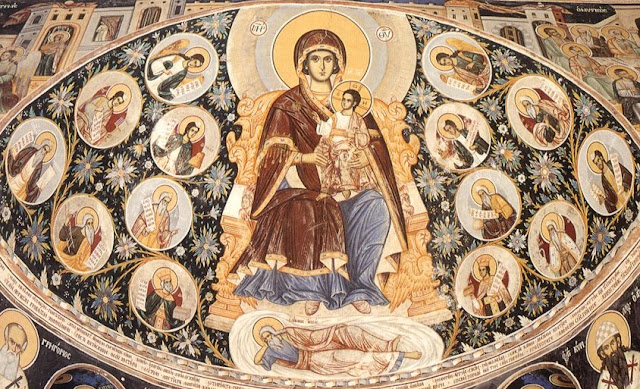The Genealogy of Jesus Christ
The Gospel reading for the Divine Liturgy on the Sunday before Christmas is "the Genealogy of Jesus Christ, the son of David, the son of Abraham", taken from the Gospel according to St. Matthew. This genealogy lists the generations of people from Abraham to David, to the Babylonian captivity of the people of Israel, to the birth of Jesus. It is a selected genealogy, ending in the appearance of "Joseph, the husband of Mary, of whom Jesus was born, who is called Christ" (Matthew, 1:16). It differs from the genealogy presented in St. Luke's Gospel, which begins with Jesus "being the son (as was supposed) of Joseph", and goes back all the way not simply to Abraham but to Adam (Luke, 3:23-38).
There are many
purposes for presenting the genealogy of Jesus in the gospels, chief among
which is the affirmation that Jesus, being in truth the Son of God, as all the
gospels testify, has come "in the flesh" as a real human being. This
affirmation was critically important in the time of the apostles and the first
Christian generations because, unlike today, the temptation of the early period
of Christianity was not to deny Jesus' divinity, but to deny His real and
authentic humanity.
As a matter of
historical fact, the first Christian heretics were those who said that Jesus
was some sort of divine being (how this was explained had many variations and
versions) who only appeared to be a true man, but was not really one since
"flesh and blood" were taken to be intrinsically degrading if not
downright evil. Thus the apostle Paul had to insist that in Jesus, who belongs
to the Jews "according to the flesh" (Romans, 9:5), the "whole fullness
of deity dwells bodily" (Colossians, 2:9), and that it is the same Jesus who died
and was buried and raised in the flesh as a real man, who is Messiah and Lord.
[…]
The genealogies
in the gospels of Saints Matthew and Luke are made to and from Joseph. This is
not to give the impression that Jesus came from Joseph's seed. Both gospels are
absolutely clear on this point. Jesus is born from the Virgin Mary by the power
of the Holy Spirit. The point is rather that Joseph is Jesus' father according
to the law, and it is from the father that one's lawful descent is to be
traced. Jesus' legal father is "Joseph, son of David", the legal
husband of Mary (Matthew, 1:20).
 One other
important point is made in listing the human generations which led to the birth
of Jesus. This is the fact that God is faithful to His promises even though His
chosen people are often not faithful. Among the people from whom Jesus came are
both sinners and heathens. In a word, Jesus comes not only from the righteous
and holy, but from the wicked and sinful. And He comes not only from Jews, but from
Gentiles. The names of the four women specifically mentioned in St. Matthew's
list - Tamar, Rahab, Ruth, and the wife of Uriah (Bathsheba) - were noted, not
to say notorious, Gentiles, including one of David's own wives, the mother of
Solomon. The point to be seen here is one beautifully made in an early
Christian hymn quoted in the Bible in the second letter to Timothy:
One other
important point is made in listing the human generations which led to the birth
of Jesus. This is the fact that God is faithful to His promises even though His
chosen people are often not faithful. Among the people from whom Jesus came are
both sinners and heathens. In a word, Jesus comes not only from the righteous
and holy, but from the wicked and sinful. And He comes not only from Jews, but from
Gentiles. The names of the four women specifically mentioned in St. Matthew's
list - Tamar, Rahab, Ruth, and the wife of Uriah (Bathsheba) - were noted, not
to say notorious, Gentiles, including one of David's own wives, the mother of
Solomon. The point to be seen here is one beautifully made in an early
Christian hymn quoted in the Bible in the second letter to Timothy:
If we have died with Him,
we shall also live with Him;
If we endure,
we shall also reign with Him;
If we deny Him,
He also will deny us;
If we are faithless,
He remains faithful –
for He cannot deny Himself. (2 Timothy, 2:11-13)
for He cannot deny Himself. (2 Timothy, 2:11-13)
This is the wonderful witness of the genealogies of Jesus: If we are
faithless, the Lord God remains faithful – for he cannot deny Himself!
Prepare yourself, O cavern,
For the Virgin approaches to give birth to her Son.
Be glad and rejoice, O Bethlehem, land of Judah,
For from you our Lord shines forth as the dawn.
Give ear, you mountains and hills
And all lands surrounding Judea,
For Christ is coming to save the people
Whom He has created and whom He loves.
An excerpt from "The Winter Pascha", by Fr. Thomas Hopko

















































